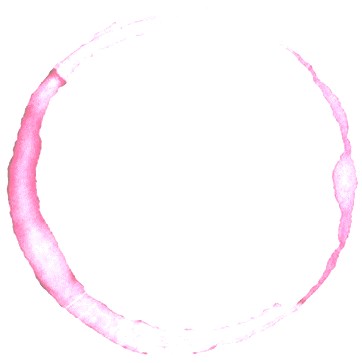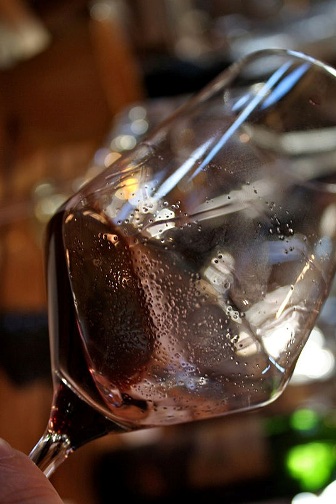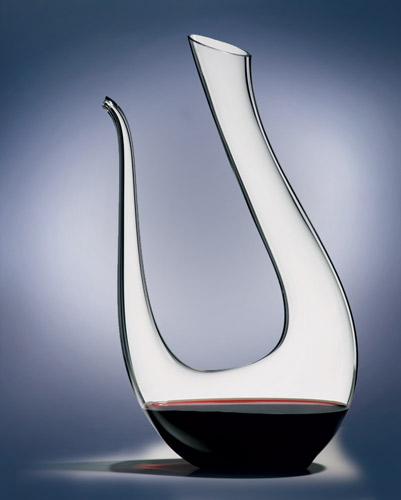
< Previous / Next >
 |
Article Index < Previous / Next > |

Decanting Wine
- Move over Wedgewood, it’s time for Riedel!
I’ll bet that you have an old china cabinet in your dining
room. I will also wager that it’s filled with the same dishes that you
painstakingly chose for your wedding registry while David Bowie was singing
songs about modern love. Can I suggest that when you’ve finished reading this
article, you will need that space for some new glassware…
In discussing wine and service, the question I am most
frequently asked is ‘should I decant the bottle after opening it?’ Decanting is
an age-old debate and many strong opinions on the subject exist, but before we
dive into a discussion, let us first define the concept. To decant is to
carefully pour the contents from the bottle into another flask of some
description. This transfer accomplishes a number of things: primarily, aeration
of the liquid, but the process also allows one to separate the wine from any
sediment that has settled in the bottle over time. To explain, I’ll let you
learn from my mistake, for in a moment of haste, I found myself scrambling down
the stairs in search of another bottle from the cellar… “Really, it’s no trouble
at all, there’s plenty of food; we’ll just set two more chairs at the table.
Please, come in and make yourselves at home.” My wife is such a good-natured
person. I had no idea they were planning to bring another couple with them,
grumbling under my breath as I slide a second bottle from its resting place
amidst the others in our cobweb crusted cellar.
 Over
time, older wine tends to throw unsightly sediment that will settle in the
bottle. To abruptly move such a bottle is certain to stir the contents, and
while the wine may appear reasonably clear as you pour, the dregs will reappear
at the bottom of each glass as you enjoy your meal. Inevitably someone at the
table will blurt out: “Hey, why is there powder in the bottom of my glass? Is
this homemade wine or something? I thought you were some kind of wine expert…”
The swine!
Over
time, older wine tends to throw unsightly sediment that will settle in the
bottle. To abruptly move such a bottle is certain to stir the contents, and
while the wine may appear reasonably clear as you pour, the dregs will reappear
at the bottom of each glass as you enjoy your meal. Inevitably someone at the
table will blurt out: “Hey, why is there powder in the bottom of my glass? Is
this homemade wine or something? I thought you were some kind of wine expert…”
The swine!
Having salvaged all but a fraction of my dignity since that
awkward moment, I’ve since learned to keep a back-up bottle of the same label in
a ready-to-go location prior each meal. It needn’t be at the table but should
certainly be standing upright somewhere convenient. If upon tasting choice
number one, you find it to be 'slightly off’ or as the lesson learned in my
case, you run short, simply call-up the understudy and decant if necessary.
The formation of sediment will always necessitate decanting
and the amount of dregs present in the bottle is a function of the type of wine,
its age, and the degree of filtration received during production. I’ll recall
from a previous article that better wine is that which undergoes the least
amount of processing i.e. filtration, chemical additives, and industrial
meddling. During the ageing process, the tannin (bitterness) and colour pigment
of the wine begin to fall out of solution as a powder-like substance in the
bottle. If you note sediment in the bottle, I suggest that you pour the wine
through a filter after standing the bottle upright the day before to allow the
dregs time to settle.
Decanting for aeration is a matter of personal preference
though you should ask yourself: when is it applicable? With prolonged storage
and partly due to the minute amount of air present in the bottle, better wine
will change, becoming less tannic, softer, and more approachable. Decanting
simply expedites this process and typically an hour or two of breathing time is
enough to smooth a young wine’s hard edges, though in some cases, you might want
to decant the bottle that you intend to serve with dinner as early as breakfast
on the same day. It really does make a significant difference.
In terms of presentation, I think you’ll agree that wine is
more enjoyable when we dress it up with a touch of class. That might include a
special meal or simply a beautifully polished glass or crystal decanter. But
what if you are partial to the bottle and would prefer that your guests see it
as well? Other than placing the empty on the table, you might consider
‘double-decanting’ which involves pouring the wine into a flask and then back
into the original bottle. By doing so, you filter out the sediment, initiate
some aeration, and can still pour from the original vessel. Just remember to
rinse out the dregs left behind in the bottle. For this, I use a little of the
wine, though water is sufficient provided you get most of it out before
refilling the bottle.
Decanting technique is more a question of style than anything
else and you can opt for the quick, easy, and failsafe method of simply pouring
the wine through a filter, or perhaps the more formal and traditional practice
of decanting by candlelight; I guarantee this will raise eyebrows, let me
explain: After allowing the sediment to settle overnight, carefully uncork and
pour the wine in one continuous motion into the decanter while watching the
candle’s flame through the neck of the bottle (a flashlight is a better source
of light, but let’s go for some pizzazz here). With the absence of a filter to
catch the dregs, you must stop pouring once the sediment begins to appear in the
neck of the bottle. The amount remaining is contaminated with sediment and
should be discarded – it’s all part of the show and with a little practice,
you’ll be able to salvage all but a swallow of the wine.
Regardless of colour or style, the majority of wine for sale
in your local wine shop does not require decanting. In general, if it follows
the 3F principle (Fun, Frilly, and Fruity) or if it comes in a box, tin can,
tetra-pack, or with a unicorn or fuzzy friend on the label, don’t insult
yourself or anyone else by suggesting that it will improve with some breathing
time – it will not. Decanting is normally reserved for full-bodied red wines
such as
A quick word on decanting white wine:
the consensus is no, do not, unless the bottle contains tartrate crystals (white
flakes floating about in the wine) or falls under the category of high-end
As for a particular style of decanter, the possibilities are
endless and you can really let your creativity run wild here. A perfectly
suitable glass decanter will cost around $10 or run you in excess of $500 for
something unusual – they do exactly the same thing. Just make sure it fits in
Grandma’s old china cabinet before you fork out the cash.
This article was written by T.Philp and first published in the Summer 2011
edition of Footprints Magazine.
| return to the Article Index | ||
Tyler Philp is a member of the Wine Writers' Circle of Canada Please direct inquires for writing services to: info@tylerphilp.com |
||
| Copyright © 2013 Tyler Philp
prior permission required for duplication of material |
||